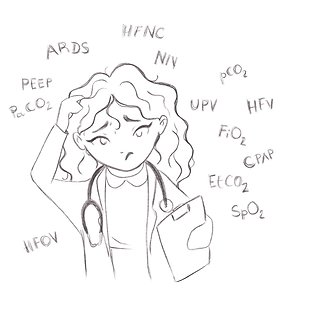Acute respiratory failure
Respiratory failure is a life-threatening condition in which respiratory system is unable to ensure adequate gas exchange which results in hypercapnia (insufficient elimination of carbon dioxide from the blood), hypoxaemia (insufficient oxygen supply to arterial blood) or both. In acute respiratory failure compensatory mechanisms occur − hyperventilation, tachypnoea and tachycardia. The algorithm presents possibilities of oxygen therapy and ventilatory support in a patient with severe respiratory failure. Regarding patient's clinical condition (vital signs, laboratory, physical examination) you will be able to recognize the (in)effectiveness of therapy and understand ventilation parameters such as PEEP, FiO2 and oxygen flow. Knowledge of individual methods, their limitations and settings is crucial for correct indication in a given patient.
Review
Severe form of acute respiratory failure (ARF) together with the most severe form acute respiratory distress syndrome (ARDS) is heterogeneous and potentially life-threatening pathological conditions. Rapid diagnosis and causal resolution of the triggering factor is inevitable when influencing the prognosis of the patient. Other vital elements in the patient´s care with ARF are correctly indicated and used supportive and rescuing interventions which enable to span the most severe phase of the disease. The view of professional public on respiratory insufficiency management has been developing dynamically in recent decades. This is in virtue not only of increase in new diagnostic methods, but also of the rapid development of interventions (technologies and indications), some of which currently belong to the standard patient´s care in critical care medicine (mechanical lung ventilation, pronation), and others are aiming for it (extracorporeal membrane oxygenation). The occurrence of various ARF forms is and will continue to be on the leading position among pathological conditions in intensive care medicine. The presented algorithm is a necessary guide to the care of the patient with ARF symptoms. It logically covers all of the phases of health care from pre-hospital to hospital. It emphasizes the need for a rapid identification of the diagnosis and an early initiation of the whole spectrum of adequate supportive and causal therapy.
Sources
BERSTEN, Andrew D. and Jonathan M. HANDY. Oh's intensive care manual. 8th ed. [Oxford]: Elsevier, 2019, p. 359-548. ISBN 9780702072215.
FONG, Ka-man and Shek-yin AU. Update on management of acute respiratory distress syndrome. AIMS Medical Science [online]. 2018, 5(2), 145-161 [cit. 2020-03-26]. DOI: 10.3934/medsci.2018.2.145. ISSN 23751576. Available at: http://dx.doi.org/10.3934/medsci.2018.2.145
GRIFFITHS, Mark J D, Danny Francis MCAULEY, Gavin D PERKINS, et al. Guidelines on the management of acute respiratory distress syndrome. BMJ Open Resp Res [online]. 2019, March 2019, 6(1), 27 [cit. 2020-03-26]. DOI: 10.1136/bmjresp-2019-000420. Available at: https://doi.org/10.1136/bmjresp-2019-000420
LODESERTO, Frank J., Thomas M. LETTICH and Salim R. REZAIE. High-flow Nasal Cannula: Mechanisms of Action and Adult and Pediatric Indications. Cureus [online]. 2018, Nov 2018, 10(11), 12 [cit. 2020-03-26]. DOI: 10.7759/cureus.3639. Available at: https://doi.org/10.7759/cureus.3639
PAPAZIAN, Laurent, Amanda CORLEY, Dean HESS, et al. Use of high-flow nasal cannula oxygenation in ICU adults: a narrative review. INTENSIVE CARE MEDICINE [online]. 2016, 42(9), 1336-1349 [cit. 2020-03-26]. DOI: 10.1007/s00134-016-4277-8. ISSN 03424642. Available at: https://doi.org/10.1007/s00134-016-4277-8
ROCHWERG, Bram, Laurent BROCHARD, Mark W. ELLIOTT, et al. Official ERS/ATS clinical practice guidelines: noninvasive ventilation for acute respiratory failure. Eur Respir J [online]. 2017, Aug 2017, 50(2), 20 [cit. 2020-03-26]. DOI: 10.1183/13993003.02426-2016. Available at: https://doi.org/10.1183/13993003.02426-2016
WHEELER, Arthur P and Gordon R BERNARD. Acute lung injury and the acute respiratory distress syndrome: a clinical review. The Lancet [online]. 2007, 369(9572), 1553-1564 [cit. 2020-03-26]. DOI: 10.1016/S0140-6736(07)60604-7. ISSN 01406736. Available at: https://doi.org/10.1016/S0140-6736(07)60604-7





